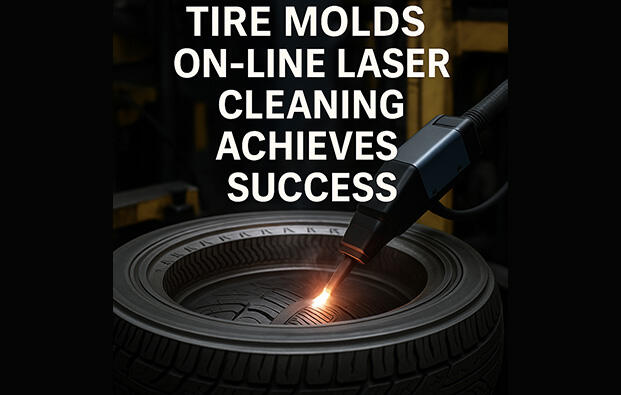As the tire industry increasingly demands higher product appearance quality, traditional mold cleaning methods—such as sandblasting and dry ice cleaning—are revealing their limitations, including suboptimal cleaning results, high noise le...
Contact Us
As the tire industry increasingly demands higher product appearance quality, traditional mold cleaning methods—such as sandblasting and dry ice cleaning—are revealing their limitations, including suboptimal cleaning results, high noise levels, and expensive consumables. The industry urgently needs a more efficient and cleaner mold cleaning solution.
Laser cleaning technology enables in-place, in-temperature mold cleaning directly on the tire vulcanization production line. This significantly reduces downtime caused by mold disassembly, movement, and reheating, making it an ideal cleaning method for modern tire manufacturing. It is poised to become a new standard for tire mold maintenance.
As tire manufacturers pursue improved surface aesthetics and advanced mold designs, tire molds themselves have evolved dramatically:
Material Advancements: Aluminum molds, which heat faster, are lighter, easier to machine, and more durable, are gradually replacing traditional steel molds. However, aluminum is softer and more prone to deformation, demanding more delicate maintenance procedures.
Design Complexity: To achieve lower rolling resistance, enhanced performance, and premium visual effects, mold patterns have shifted from simple vertical blocks to intricate crisscross designs. Pattern blocks have become smaller and more fragmented, increasing cleaning difficulty.
Velvet Sidewall Tires: High-end velvet sidewall tires have a suede-like finish with extremely fine textures. Compared to standard sidewall patterns with a 0.50 mm minimum spacing, velvet molds have spacing as narrow as 0.17 mm—significantly raising cleaning complexity.
Spring-Type Vent Sleeves: New molds with spring-loaded vent sleeves (as opposed to rubber post sleeves) feature 30% more vents and a more intricate structure. Sandblasting often clogs these fine vent holes, making the method unsuitable.
These advances demand higher-performance cleaning methods. Below is a comparison of major mold cleaning technologies.
Sandblasting uses compressed air to propel plastic or glass beads onto the mold surface. It was widely used when steel molds with simpler patterns were common.
Drawbacks:
Requires mold disassembly, reheating, and realignment, wasting 8–12 hours and reducing machine availability.
Frequent removal can impair mold and machine alignment and necessitate additional mold inventory.
Damages softer aluminum molds and intricate textures.
Produces dust pollution and poses occupational health risks. Environmental regulations, such as those in Shandong Province, have already begun phasing out sandblasting equipment.
Dry ice particles are blasted onto hot molds. The extreme cold (-78.5°C) freezes and fractures dirt, and the sudden expansion of gas (800x volume) dislodges contaminants.
Advantages:
Enables in-place cleaning within 2 hours, avoiding disassembly and preheating delays.
Reduces mold wear, increases production uptime.
Limitations:
Less effective on deep or fine grooves.
Noisy (80–90 dB), creating a harsh work environment.
Close contact with hot molds increases burn risk.
Laser cleaning uses high-frequency, high-energy laser pulses to instantly vaporize, evaporate, or shake off surface contaminants.
Key Benefits:
Non-abrasive, non-contact, and no thermal damage.
Leaves mold surfaces intact—ideal for soft aluminum molds and intricate patterns.
No dust or noise pollution.
Widely regarded as the “beautician of manufacturing.”
Traditionally, laser cleaning was limited to offline applications requiring mold disassembly. However, advancements in automation and industrial vision systems have enabled online laser cleaning—real-time, in-place mold maintenance.
Modern laser cleaning robots use 3D vision to scan mold geometry, calculate optimal cleaning paths and angles, and execute full 360° cleaning via six-axis robotic arms. This innovation improves efficiency, lowers labor costs, and maintains machine-mold alignment.
Table 1: Comparison of Advantages and Disadvantages of Mould Cleaning Methods (2 Sets of Full Steel Moulds)
| Item | Sandblasting Cleaning | Dry Ice Cleaning | Offline Laser Cleaning | Online Laser Cleaning | |
| Time Consumption | Disassembly |
3h
|
- |
3h
|
- |
| Cleaning | 2h | 1.5h | 1.5h | 1.5h | |
| Preheating | 3h | 0.5h | 3h | 0.5h | |
| Operating Personnel |
Disassembly (2 Persons) Cleaning (1 Person) |
Cleaning (1 Person) |
Disassembly (2 Persons) Cleaning (1 Person) |
Fully Automatic Cleaning | |
| Equipment |
Affects the Accuracy of the Vulcanizer and Moulds Mould Wear Not Suitable for High-End Pattern Moulds |
Mould Wear is Less than Sandblasting Cleaning Not Suitable for High-End Pattern Moulds |
Affects the Accuracy of the Vulcanizer and Moulds | - | |
| Consumables | Plastic or Glass Abrasive Granules | Dry Ice | - | - | |
| Energy Consumption |
High Energy Consumption |
High Energy Consumption Electricity, High-Pressure Air, Water |
Electricity | Electricity | |
| Safety and Environmental Protection | Dust Pollution | Pollution, Dust Pollution, Personnel Burn Risk | - | - | |
Online laser cleaning eliminates the need to remove molds from the vulcanization machine, significantly shortening downtime and enhancing productivity. Although dry ice cleaning is currently the most mature method for this purpose, its issues—worker safety, noise, consumable costs, and pollution—are increasingly problematic.
This has sparked growing interest in laser cleaning for hot molds in place, focusing on:
System Compatibility: Molds and vulcanization machines vary significantly—lift-translate, lift-rotate, sunken, surface-mounted machines, front/rear robotic arms—all present space and layout challenges for automation systems.
Laser Reachability in Complex Geometries: As tire treads become more sophisticated (ribbed patterns, grooves, sipes, square or round shoulders), reaching and cleaning every contour with a laser becomes a critical technical hurdle.